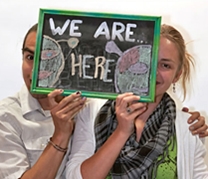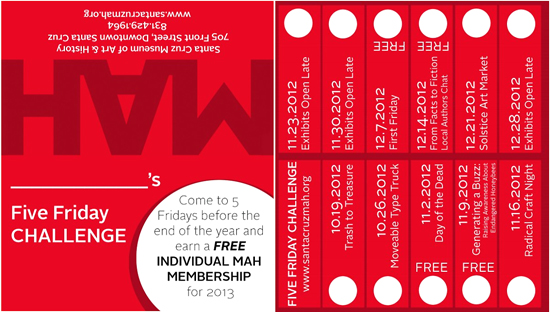Grant Spotlight | October 1, 2014
Share This
 |
|
Recipient: Santa Cruz Museum of Art and History at the McPherson Center Grant: Sparks! Ignition Grants for Museums; 2012 Pictured: Visitors participate in a 3rd Friday photobooth |
|
Project Contact: |
Karen Bush had several “aha! moments” during a Loyalty Lab visitor experience workshop. In a recap post on the Santa Cruz Museum of Art and History (MAH)’s Loyalty Lab blog-style website documenting the work in real time, the membership director described one of them. She realized that “having a great time doesn’t necessarily make people feel connected to the institution. We have more work to do on making what feels like an active and thriving community of visitors to us feel like a thriving and connected community to those participating.”
Bush added, “I am really curious to find out through experimentation if physical objects can help fill this gap—what is the effect of a membership card or a punch card or a sticker on personal connection to a place.”
Exploring the Visitor Experience
With the IMLS-funded Loyalty Lab project, MAH developed strategies to track, celebrate, and deepen engagement with visitors—91 percent of whom are Santa Cruz County residents. The project goal was to celebrate and cultivate deeper relationships with participants by experimenting with low-tech, low-cost techniques for tracking and rewarding participation.
“We are interested in how we can engage with participants in an authentic and relationship-based way,” said Nina Simon, Executive Director of Santa Cruz Museum of Art and History.
The museum staff personally knew frequent visitors, but the Loyalty Lab helped them build relationships in a systematic way with rewards, events, and follow up interactions.
The museum hired Adaptive Path, a user experience design firm, to host a workshop with museum staff, visitors, trustees, and members. Workshop participants discussed the onsite visitor experience and identified opportunities to reward visitor loyalty.
Experiments in Engagement
“Before, we had a scattered approach to repeat visitation and engagement. The museum always had greeters,” said Simon. “We learned from the workshop that visitors entering the museum were already excited and wanted to engage, but we were missing an opportunity to keep people in the loop, to subscribe to our lists, or become members.”
The museum developed two experimental prototypes to test the hypotheses around visitor loyalty. The first was “Five Fridays,” a punch card challenge that sought to answer Karen Bush’s question of the effect of physical objects on enhancing community participation. It also tested whether the museum could build a habit of museum patronage on Friday nights, when most of its programming took place. The museum offered anyone who visited the museum five select Fridays from late October through end of the year a free membership for following year.

Museum of Art and History at the McPherson Center Five Friday Challenge punch card
This approach, which used game mechanics to get people more involved, changed preconceptions about the ideal number of museum visits in a given timeframe. Museum staff was surprised when only seventeen people completed the challenge, even though it took place during a typically busy holiday travel period and was offered to 500 visitors.
Santa Cruz Museum of Art and History also increased its use of photo booths at museum events to document and celebrate visitors’ actions, and introduced a volunteer “Goodbyers” squad to connect the museum experience with future interactions at the museum. The “goodbyer” squad focused on thanking people for coming and handing them flyers on the way out about upcoming related events. Volunteers also signed people up for the museum’s email newsletter, which is the primary way people learn about the museum. This provided the museum a way to stay in touch with visitors who were brought to the museum by friends and may be interested in upcoming events and programs.
Applying the Knowledge
The museum hosted another workshop with game designers and museum professionals from across the U.S. to share the results of “Five Fridays” and learn about other projects from peers. MAH is now moving from the experimentation phase to implementing mainstream protocols for volunteer “goodbying” into all of its events; building up post-event online engagement through follow-up emails, photographs on Facebook, and story sharing from the experience; and sourcing and developing a data tracking system for its visitors and members.
Through Loyalty Lab, the museum learned to examine ephemeral and often anecdotal ways that it connects with its museum visitors. From this experimentation and observation, the staff aims to continue to capture these trends, draw on the knowledge, and ultimately make better programs.
